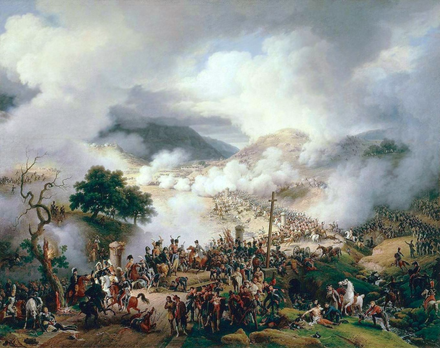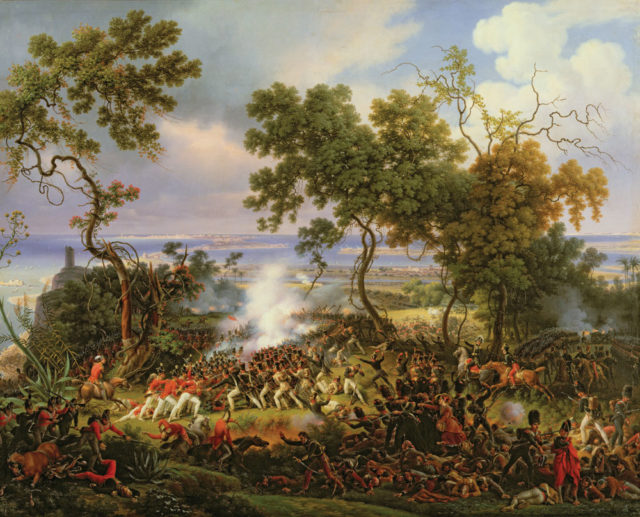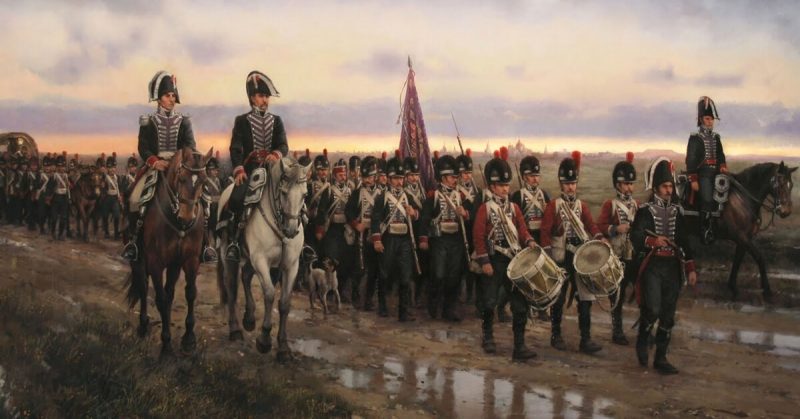The Peninsula War was the most drawn-out campaign of the Napoleonic wars. French troops entered the Iberian Peninsula in 1807 and along with Spanish forces invaded Portugal. In 1808 France turned on its ally, Spain and fought that country until 1814.
Here are some facts about the armies Napoleon sent.
An Unpopular Posting
Service in the Iberian Peninsula was unpopular among regular French troops. The resistance of local guerrillas made life dangerous and uncertain. The politically savvy knew their government had betrayed an ally in seizing Spain.
As Marshal Macdonald later said, “I had a very strong objection to the way the war was carried on in Spain; my objection had its root in the dishonesty… the resistance of its inhabitants triumphed over our efforts and arms… [life there] was as odious as it was exhausting.”
A Brief Visit from the Emperor
Napoleon was only present in the Peninsula for just over two months during the seven-year war. He took command of French forces in Spain on November 3, 1808. On January 1, 1809, he ended his pursuit of the British General Moore so he could return to France and prepare to fight Austria.
He tried to control his army’s actions in the Peninsula. While based in Paris, he sent orders to troops at the front. The delay in information traveling to and from Paris meant those orders were often based on out of date information and were irrelevant if not dangerous to follow. It was the worst sort of micromanagement and it was a failure of command by one of the world’s greatest generals.
A Variety of Guardsmen
The Imperial Guard, Napoleon’s elite troops, arrived in the Peninsula before he did. Napoleon’s brief period of command in the area saw their numbers substantially increase. The elite regiments supplied Fusiliers, cavalry, artillery, and even seamen.

90 to 156 Infantry Regiments
Infantry made up the bulk of the armies fighting in the Peninsula. At the start of the war, the French had 90 infantry regiments, at least 72 of which served in Spain at some point. As the war ground on, more were sucked in due to the wider escalation of warfare and Napoleon introducing conscription. By the end of the war, the French had 156 infantry regiments, at least 84 of which had fought on the Spanish front.
Foreign Fighters
The Napoleonic armies included troops from across Europe as countries bought into the French cause through alliance or conquest. In Portugal and Spain, Swiss troops played a particularly prominent role. Germans were also common. With Spain officially part of Napoleon’s Empire, many Spaniards fought for or alongside the French, although many also fought against them.
Confusing Coats
In most circumstances, it was usually possible to distinguish between the opposing sides – the British in their red coats and the French in blue. Allied troops added a complication. Three Swiss regiments wore red uniforms, leading to confusion between them and the British both in battle and on a campaign.
Dwindling Units
Casualties, desertions and the challenge of providing replacements affected unit sizes. As the war progressed, forces were fielding far lower numbers than they theoretically should have had.
At the siege of Badajoz in 1811, the French had seven cavalry regiments. Only two had their full complement of four squadrons; the others had two each. Unit sizes varied hugely with the availability of men. At the second siege of Saragossa, the average squadron size was 251 troops. At Tarragona, it was only 148.
Massive Artillery Train
Artillery played a vital part in the war. There were more sieges in the Iberian Peninsula than on other fronts, making cannons crucial in the bombardment of defenses. They also served an important part on the field of battle.
To transport the guns, 13 Battalions of Artillery Train served in the Peninsula in 1808, doubling to 26 in 1810. There were also battalions of artillery workmen to help them.

Engineers
Specialist engineering units also served. They included battalions of sappers and companies of miners, essential in undermining walls during a siege. They were supported by units of pioneers, including the Pioneers Blanc made up mostly of Austrian prisoners of war.
Failure to Cooperate
Without Napoleon around to keep an eye on them, cooperation was not good between the marshals commanding troops in the Peninsula. They followed their own interests and agendas, at the expense of failure in overall performance. The situation was so bad Napoleon put his brother Joseph, the puppet King of Spain, in overall command, even though Joseph was a politician rather than a commander. It was no help, as commanders such as Marmont, Soult, and Suchet refused to obey Joseph.
Unfortunate Troop Withdrawals
Napoleon’s focus on other fronts led to much-needed troops being pulled out. The 1812 invasion of Russia was particularly draining. Some troops were withdrawn beforehand to become part of the new army. Then, when Russia turned into a costly failure, more men were taken to replace those lost amid the snows.
The Navy – Little Activity, Few Losses
By the time of the invasion of Portugal, France had already lost to the British at sea. Trafalgar left the Royal Navy totally dominant. Napoleon did not even try to field fleets against them as part of the Peninsula War.
The result was the French struggled to move supplies, which could have easily been transported by sea. Smaller ships were used to move supplies around while avoiding British attention. Over the whole course of the Peninsula War, only 16 ships of the line were lost. Six of them surrendered after being trapped in port by vastly superior British forces.
Source:
Philip Haythornthwaite (2004), The Peninsular War: The Complete Companion to the Iberian Campaigns 1807-14
